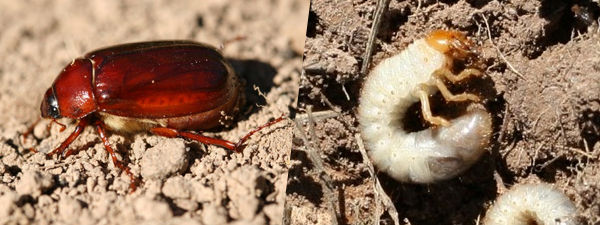White Grubs in Corn and Soybeans
December 7, 2018

White grubs are the immature forms of scarab beetles, or the well-known May-June beetles, masked chafers and Japanese beetles. Several species of white grubs are found in soybean and corn growing regions. While some grubs rarely feed on corn and soybean seedlings, others may do so for parts of one or more seasons. White grubs are an occasional pest; growers may experience them one season but not the next.
Identification and lifecycle
Take care to properly identify white grubs, as some grub species have different feeding methods and lifecycles. White grub larvae first feed on organic matter in the soil and later begin feeding on corn and soybean roots, according to North Dakota State University.
The white grub is ¼ to more than 1 inch long with a brown head and six prominent legs. Its body typically is curved into a “C” shape.
May-June beetles have a two- to three-year lifecycle. The grub stage occurs from August throughout the following year. It may also continue through part of a third consecutive year. Masked chafers and Japanese beetles have a one-year lifecycle, with a grub stage from late July through mid-June the following year.
Crop damage
Stunted, wilted, discolored or dead seedlings may emerge when white grubs attack, and farmers may see gaps in rows where plants fail to emerge. White grubs eat roots and attack stems, causing plants to wither and die.
Corn and soybeans with white grub injury usually have been planted in fields that were previously used to grow sod or some other cover crop. May-June beetles prefer to lay their eggs in grasses, soybeans and, to a lesser degree, corn.
Scouting
If farmers observe signs of injury, they should dig up a few affected corn or soybean plants, check the root zone for white grubs and examine the seedling root system to assess possible damage. Purdue University offers a great tip on using the hair patterns on the insects’ posterior ends to identify which species of grub is in a field.
When scouting fields, start at a different point each week. Choose a random pattern in advance. Walk that pattern and don’t consciously pick out good spots or bad areas.
Take samples of insects and possible insect damage while looking at plants around the sample site. While walking from one site to the next, scan the entire field. Look for variations and patterns. If insects and damage are not easily identified, consult county Extension personnel or a pest identification guide.
White Grub best management practices
In no-till or limited-till situations, white grubs may become established on existing vegetation and move to emerging corn and soybean seedlings once this vegetation is controlled. Risk of white grub attack can be greatly reduced by destroying all existing vegetation by cultivation or herbicides, including a burndown and preplant residual herbicide, two to four weeks before planting. Removing existing vegetation prior to planting will also provide better penetration of insecticide spray or granules.
In corn, Bt hybrids vary in their efficacy against white grubs. The same is true for soybean varieties. To help determine severity of infestation, look for white grubs turning up on top of the soil during seedbed preparation.
The best approach to manage white grubs and other insect pests in corn and soybeans is preventative control. Bayer offers season-long insect pest control options, from insecticide seed treatments to foliar insecticide products.
Seed treatments
Starting off with a good seed treatment is an excellent way to control insects and protect corn and soybean plants above and below ground.
Insecticides
Baythroid® XL insecticide, a pyrethroid, performs on a broad spectrum of corn and soybean insect pests, with fast knockdown and long residual control.
Baythroid XL may be used in corn crops to fight back against white grubs throughout the growing season; however, application timing should be based on careful scouting and local economic thresholds.
For more information about insect control options in corn and soybeans, and Baythroid XL insecticide from Bayer, please contact your local Crop Science US representative.
For more information about insect control options in corn and soybeans and Baythroid XL insecticide from Bayer, please contact your local representative.
Always read and follow label instructions. Not all products are registered for use in every state. Baythroid XL is a Restricted Use Pesticide.